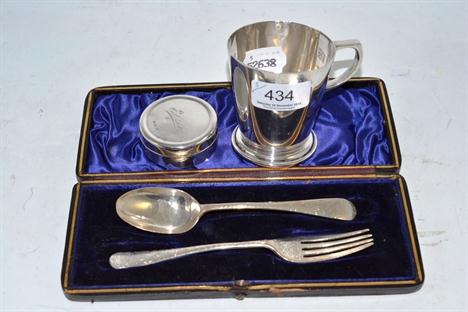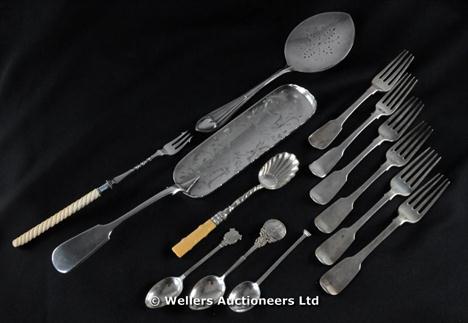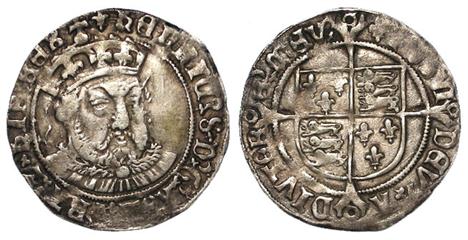We found 45628 price guide item(s) matching your search
There are 45628 lots that match your search criteria. Subscribe now to get instant access to the full price guide service.
Click here to subscribe- List
- Grid
-
45628 item(s)/page
AN EARLY 20TH CENTURY SILVER MUSTARD of rounded rectangular form having a domed, finial topped, hinged cover with Bristol blue glass liner and associated pickle fork, raised on shaped legs, marks for Sheffield 1930, maker Cooper Brothers & Sons. 5.5cm(h) x 9.5cm(w) 86grams(minus liner) Condition Report: Chip to liner, some tarnishing but ok.
Misc. silver & plated items, comprising set of six silver-handled cake knives, set of six silver-plated cake forks, should be seven, one fork missing, set of five plated dinner forks & knives, plus EPNS fish slice & fork, latter two sets with simulated ivory handles, sugar bowl & sugar tongs (4 cased sets of cutlery & 2 items) Care! High International Shipping
3 whistles: by J Hudson & Co, B’ham 1916, on steel fob chain; Acme Thunderer marked “LMS”; J Hudson & Co with broad arrow and 1945; 2 other whistles on a loop of steel chain; an Austrian “Goal” patent cigarette lighter; a trench art brass cross bound wiht copper wire; and a folding fork and spoon with white plastic side plates (one AF). Average GC
An Edward VII Pistol-Handled Suite of Silver Flatware, Francis Higgins, London 1905, each piece engraved with gothic initial S, comprising eighteen table knives with steel blades, eighteen triple-tine table forks, eighteen dessert forks, nine dessert knives with steel blades, a carving knife and fork; and A Pair of Georgian Silver Sugar Tongs (qty)
*Die-Cast Toys. A group of mid 20th-c. toys & models by Dinky Toys and others, c. 1940s-1960s, comprising Rolls-Royce, Jaguar, Mini-Minor, Dyna-Panhard, Triumph, Volkswagen and Bedford `Dinky Toys` Utility Van, Bedford `Karrimore` Transporter, Fork-lift truck and commercial vehicles etc; also with Corgi Toys and Spot-On makers examples including Zephyr Zodiac `Police` car, Rover 3.0 litre, BMW Isetta, Ford Thames camper and Goggomobil etc, mostly good conditions, some play worn (approx. 23)
*Flying Officer C. McLaren-Reid, Royal Air Force, Boei Glodak P.O.W. Camp, Java 1942-45, A rectangular teak table top inscribed with the names of all the R.A.F. Officers and Warrant Officers at the time of imprisonment in Boei Glodok, 1942-45, the top left with characters for the Japanese equivalent of McLaren-Reid`s initials, with central design of the solitary confinement cells, within chain border and bottom link inlaid with signed silver plaque of Mountbatten of Burma, 50cm x 85cm, together with an number of original documents relating to the table top, including, Letter from Buckingham Palace dated September 1945, welcoming Reid home, a letter confirming release of the table from Customs 1946, Caxton Exercise Book with names and addresses of the names on the table top, an archive of letters from fellow prisoners and their families, photographs Japanese Prisoners in Batavia formerly connected with Allied Prisoners-of-War, portrait photograph of Reid in uniform and one Reid and the table top, newspaper cuttings detailing the story of the table top, documents discussing the table top being exhibited at The Scottish United Services Museum in 1949 R.A.F. section at the Edinburgh Castle, exhibited with other P.O.W. work from the Napoleonic Wars. The Clarion magazine published 1949, detailing the story of the table top, also included in the lot is a heavy silver cigarette case engraved with heraldic crest and motto `Nihil Amanti Durum` (nothing is hard for one who loves), the reverse engraved with a record of service from January 1916 - February 1953, approx. 5.5 oz, Birmingham 1943, and three personal photograph albums, mainly post WW2. The Tale of a Table, Java 1942, The R.A.F. orderly room in Boei Glodak, the civil gaol in Batavia for long-term prisoners, in half of which some 1200 R.A.F. personnel were crowded, was a cell-like room in the administration block some twelve feet by six. The furniture consisted of one small table, a chair and a couple of empty boxes, and the table did duty for the C.O., myself and the clerk, as necessity demanded. After cajoling, threatening and imploring the officer in charge of the workshops for a month or more an extra table was made for myself. The table was made from old sleeping boards used by the civil prisoners in peace time, but found to be hopelessly bug-ridden as to be unusable by our men. The top was a single piece of teak, approximately thirty-four inches by twenty inches. As Adjuntant and interpreter, my time was more than fully occupied for the first three months, but after that things got easier, and I occasionally found myself with nothing to do, there being very few available. The then Japanese Commandant, a regular officer, had encouraged arts and crafts, and a successful exhibition had been held, many of the exhibits being made by expert hands. One day it crossed my mind to do something of the sort myself, and the idea of carving the names of the Officers and Warrant Officers on my table occurred to me. I found that I had more space than was needed, so included a view of the solitary confinement cells. I finished up by placing a symbolic chain round the outside, the links being copied from the chains used on the civilian prisoners. I managed to borrow an extremely blunt and jagged-edged gouge for a short while to remove the wood to give depth to the picture, but, apart from that, had only one blade of a `Dewars` advertisement penknife, a bone handled nail file and a sharpened nail or two to work with. It took nearly four months to complete and looked a pretty amateurish job when I had finished, but it kept me occupied and I was quite pleased with, not to say proud of it. In October, the night before our first draft left, I got everyone available to autograph the back of it, but one man would never be there to sign. He had been captured one night early in April with two Sergeants pilots while making a gallant and very nearly successful attempt to steal an aircraft from the local aerodrome, after they had escaped from the gaol and made their way through the town. We never saw them again. I put a coating of brown boot polish on the carving, made a three ply cover for it, and was looking for a place to hide it when, quite unexpectedly, in January 1943 the R.A.F. were moved to a camp at Tandjong Priok, the port for Batavia. Before leaving I handed it over to a Dutch friend, Lieut. G. Vischer, R.N.N.R. to hide for me. We stayed at Tanjong Priok only three months, and were moved to `Cycle Camp`, Batavia, an old Dutch army barracks. Here I met Lieut. Vischer again. His crowd had been moved suddenly from Boei Glodak the day after we left, so he had handed the table over to an Ambonese officer, who had been unable to hide it before he himself left and the gaol was closed. The gaol was re-opened for some months as a rope-spinning factory, and several hundred British personnel went there from `Cycle Camp`. The Adjutant found the table and looked after it, but, when the time came to leave, was too busy to hide it, so once again it was left lying about. Although they closed the gaol again the Japanese decided to keep on the vegetable gardens around the gaol, and for quite a while a party went there daily from `Camp Cycle`. The Dutch officer in charge of the party told me that he had been inside the gaol, and had seen the table stowed away in a furniture store. And that was the last I heard of it up to the time I left Java at the end of September, 1945. London 1946 One day in June my friend Dudley Grundy telephoned to my flat and said he had great news for me. He had just heard from `Wiggie`, Squadron Leader C.C. Wigram, that the table had been found. Wiggie had just arrived from India, where he had been recuperating after our release, and on the way home in H.M.T. `Cape Town Castle` had met a Wing Commander of the R.A.F. Regiment. It transpired that the latter had been in Java, particularly Batavia, and, while describing what had been going on there after the arrival of the British, mentioned that one of his raiding parties had found a bit of wood with a lot of names mentioned on it, and had taken charge of it. Wiggie recognised the description as that of my table top, and told the Wing Commander that he knew the owner and would pass on the information. As a result I got in touch with the Wing Commander, who told me that the carving was in safe hands, but he could not say where. At his suggestion I went to the Historical Records Section of the Air Ministry it was not there, but a lot of stuff was expected from Singapore, and I was assured that if it arrived I would be informed at once. I then wrote to the Officer in charge of the Historical Records Section in Singapore asking him to keep it, if he had it, as I was sailing for Malaya very shortly. I received no answer to this letter. When I reached Malaya I started my search again. After a number of letters had been written and answered I traced the table top to the R.A.F. Provost and Security Services in Singapore, in whose custody it was pending onward transmission to the War Museum. I then wrote to the Air Officer Commanding-in-Chief S.E.A. asking for the necessary authority for its release, and, on 8th December, 1946, saw it again after nearly four years. It was a bit knocked about. Several of the letters were chipped and vandals had seen fit to knock a few rusty nails into it, but the boot polish finish was still there. The autographs on the back had nearly all faded away, and did so completely when I oiled the wood. I finished off the carving by inserting the date of our release, and by splitting the bottom centre link of the chain, which, with justifiable optimism, I had made larger than the others, in preparation for the day when our bonds would be broken. (I did not explain this to the Japanese who saw the table!)Now there was one thing left to do. There was space inside the broken link for an autograph, and there was one person only whose name I wanted there. I intended sending the carving itself to England, but it was bulky, and would be inconvenient; in addition to which it would take months to get there and back. Instead of this I took the spoon and fork which I had used throughout my prisoner-of-war time, which constituted the last of the `Family silver`, the remainder having been looted from my house in Malaya, to a local silver-smith, who made a flat plate out of them. This I posted home by air mail, and, in a few weeks, it was returned, autographed, together with a short but gracious letter. A coat of varnish to keep the silver from oxidising and into its place it went. Of those whose names are on the carving the majority are alive. I send them this card as a memento of hard times shared, and with my best wishes for the future. To the relatives of those who are gone, I offer it as my humble tribute to the memory of the dead.()
A hallmarked silver mustard spoon, a kings pattern silver plated soup ladle, together with a cased set of six mother of pearl handled fish knives and forks, a 1970`s wood handled steak knife and fork set and a small quantity of silver plated holloware and flatware etc., various dates and makers.
George Jones majolica cheese dome and stand, formed as a castle tower with moulded ivory decoration, base with registration lozenge and painted number 3341, 32cm high The dome has one crenulation broken off - see images, the knop is crazed and slight rubbing to the very tip, appears sound, there is a hairline running from the foot of the dome which then divides into a three pronged fork reaching almost the top edge of
A GROUP OF SIX RUSSIAN SILVER AND ENAMELED UTENSILS, CIRCA 1900-1917. Each hallmarked and each with 84 or 88 silver standard. In order of illustration they are, a shaded enameled demitasse spoon (6th Artel), a cloisonné enameled teaspoon (Dmitri Nikolaev), cloisonné enameled sugar tongs (displaying the Imperial Warrant), a cloisonné enameled sugar scoop (Khlebnikov), a cloisonné enameled fork (Klingert), and a cloisonné enameled teaspoon (Klingert). Greatest length 5.6 inches (14.4 cm).
CHINESE CARVED IVORY BRUSH POT & TOOLS A Chinese reticulated carved ivory brush pot depicting crane with lotus blossom and lily pad on vines with rock formations. Includes polychromed fork and spoon with two Hors d`oeuvre pins. Bottom of pot marked Ming dynasty, but made mid to late Qing dynasty period. Brush pot measures 3" height (7.6cm). Spoon and fork measure 5 1/2" length (13.9cm). Pins measure 3" length (7.6cm). Total ivory weight of 127 grams.
-
45628 item(s)/page















































